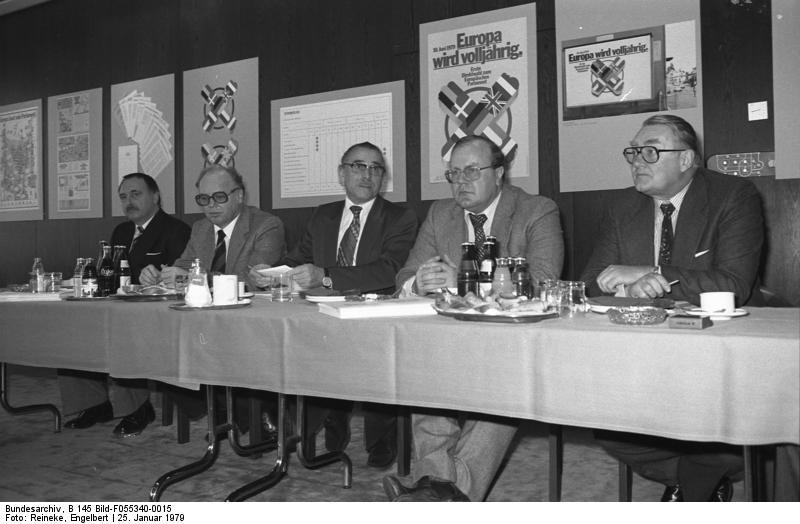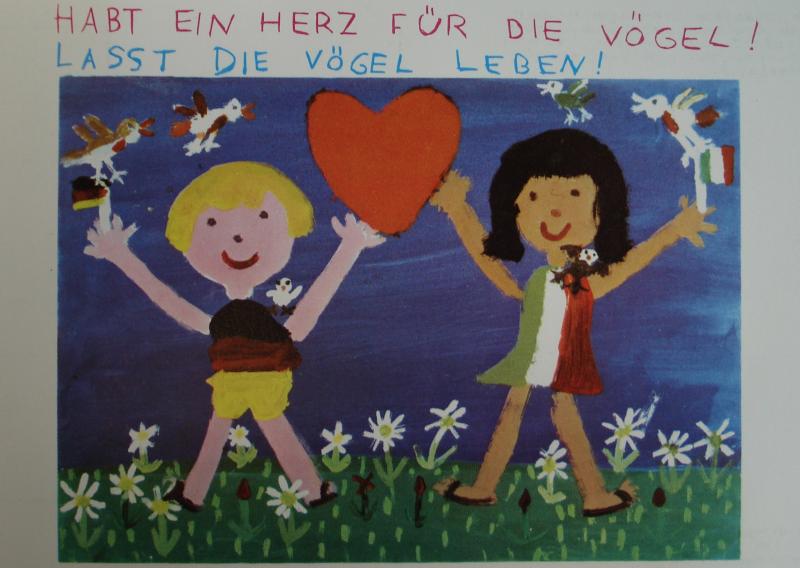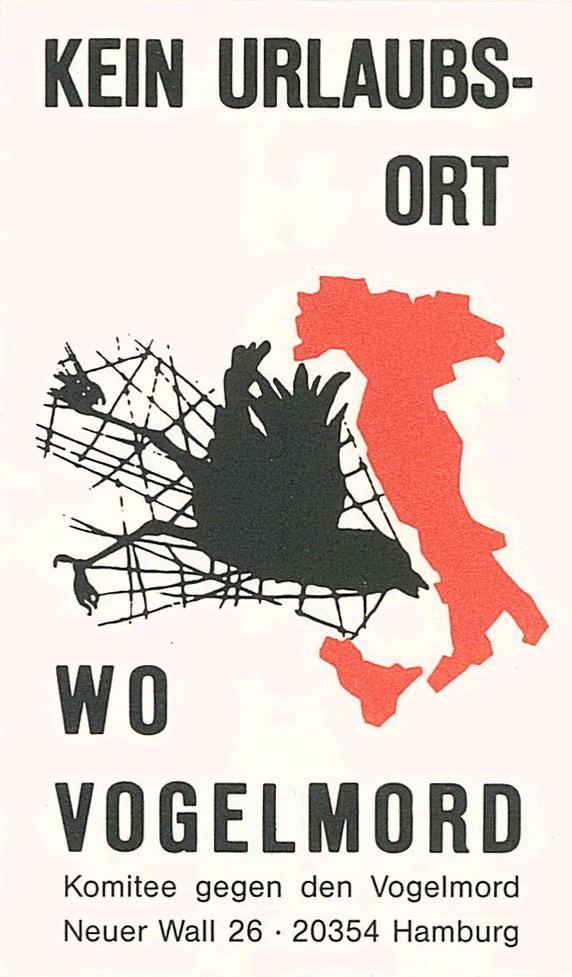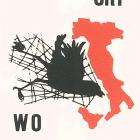Bird protection was hardly the most likely issue for the European Communities (EC, the predecessor to the European Union), to take on board as one of their first pieces of environmental legislation. Nevertheless, in April 1979—just a few years after the start of an EC environmental policy in 1973—the EC adopted the Council Directive on the Conservation of Wild Birds (79/409/EEC), the so-called “Birds Directive.”
Bird protection is of course a long-time concern of nature conservation. Bird protection associations date back to the late nineteenth century. In the wake of Rachel Carson’s Silent Spring (1962) and the rise of modern environmentalism since the 1960s, people in Europe started worrying that migratory birds would go extinct. Media in northern Europe blamed the cruel and ruthless hunting practiced in southern Europe, notably Italy.
Against this backdrop transnational cooperation among bird protection activists played a crucial role in turning the cross-border problem of migratory birds into an issue of supranational European legislation. However, in spite of the ornithological expertise of the older, well-established bird protection associations, including the Royal Society for the Protection of Birds (RSPB) or the Deutscher Bund für Vogelschutz (DBV, today Naturschutzbund Deutschland, NaBu), they were not the ones who placed the issue firmly on the agenda of the EC. Rather, it was groups that were much more radical with regard to their ideas and actions.
Motivated by deep ecological ideas, the Dutch Stichting Mondiaal Alternatief (Foundation for Ecodevelopment)—supported, among others, by the German Committee against Bird Slaughter (Komitee gegen den Vogelmord), which had emerged from the animal protection movement—submitted a petition “Red de trekvogels / Save the Migratory Birds” to the EC institutions in 1975. This got the ball rolling.
To be sure, members of the—then powerless and unelected—European Parliament (EP) had raised the issue before in parliamentary debates since the late 1960s. When the EC started its first environmental action program in 1973, bird protection was part of the agenda, albeit as an issue of research and international cooperation, not of legislation. However, the vice-chair of the EP’s environmental committee Hans Edgar Jahn, a German Christian Democrat, grasped the opportunity the petition offered to him, and prepared a parliamentary motion calling upon the European Commission to propose binding EC legislation to protect Europe’s birds.

Christian Democrat Hans Edgar Jahn (middle), member of the European Parliament, cooperated closely with bird protection activists in the run-up to the first European elections (1979)
Christian Democrat Hans Edgar Jahn (middle), member of the European Parliament, cooperated closely with bird protection activists in the run-up to the first European elections (1979)
1979 Engelbert Reineke, Bundesarchiv, B 145 Bild-F055340-0015.
Click here to view Wikimedia source.
 This work is licensed under a Creative Commons Attribution-NonCommercial-ShareAlike 3.0 Unported License.
This work is licensed under a Creative Commons Attribution-NonCommercial-ShareAlike 3.0 Unported License.
Subsequently Jahn started cooperating with an emerging European network of bird and nature protection activists. This included Germany’s most prominent environmentalist, TV host and director of the Frankfurt Zoo Bernhard Grzimek, as well as Italian bird protection groups. They bombarded the European Commission with letters calling for common European rules. And indeed, in 1976 the Commission proposed legislation, having consulted not only Grzimek, but also experts from the traditional bird-protection groups, notably the RSPB, on what to include in the draft.

“Have a heart for birds. Let the birds live!” proclaims a postcard distributed by Komitee gegen den Vogelmord. Their fund-raising campaign featured children’s drawings and the plea “prevent a ‘Silent Spring’” (printed on the back).
“Have a heart for birds. Let the birds live!” proclaims a postcard distributed by Komitee gegen den Vogelmord. Their fund-raising campaign featured children’s drawings and the plea “prevent a ‘Silent Spring’” (printed on the back).
All rights reserved © 1979 Komitee gegen den Vogelmord
This work is used by permission of the copyright holder.
As the French and Italian governments—under pressure from the hunting groups—fiercely resisted the proposed directive, and delayed its enactment, bird protection groups engaged in comprehensive letter-writing campaigns. They targeted national governments at home and, in particular, the reluctant French and Italian ministers. The European Environmental Bureau—founded in 1974 as the umbrella organization of European environmentalists—helped to coordinate their campaigns. The older bird protection associations however eventually established their own Working Group of European Bird Protection Societies (WEBS). Building on earlier cooperation within the International Council of Bird Protection (ICBP), it laid the foundations for their European association, Birdlife Europe, which was founded in the 1990s.
When the directive was finally enacted after much haggling and compromising, the bird protection movement had become pan-European—much like the birds themselves.
How to cite
Meyer, Jan-Henrik. “How Birds Became Europeans: Bird Protection Activists Cooperating across Borders for Supranational Protection.” Environment & Society Portal, Arcadia (2013), no. 20. Rachel Carson Center for Environment and Society. https://doi.org/10.5282/rcc/5652.
ISSN 2199-3408
Environment & Society Portal, Arcadia
 This work is licensed under a Creative Commons Attribution-NonCommercial-ShareAlike 3.0 Unported License.
This work is licensed under a Creative Commons Attribution-NonCommercial-ShareAlike 3.0 Unported License.
2013 Jan-Henrik Meyer
This refers only to the text and does not include any image rights.
Please click on the images to view their individual rights status.
- Boardman, Robert. The International Politics of Bird Conservation: Biodiversity, Regionalism and Global Governance. Cheltenham: Edward Elgar, 2006.
- Meyer, Jan-Henrik. “Saving Migrants: A Transnational Network supporting Supranational Bird Protection Policy in the 1970s.” In Transnational Networks in Regional Integration: Governing Europe 1945–83, edited by W. Kaiser, B. Leucht, and M. Gehler, 176–98. Basingstoke: Palgrave, 2010.
- Meyer, Jan-Henrik. “A Good European? Hans Edgar Jahn—Anti-Bolshevist, Cold-Warrior, Environmentalist.” In Living Political Biography: Narrating 20th Century European Lives, edited by A.-C. L. Knudsen and K. Gram-Skjoldager, 137–59. Aarhus: Aarhus University Press, 2012.
- Meyer, Jan-Henrik. “Zivilgesellschaftliche Mobilisierung und die frühe europäische Umweltpolitik: Die Vogelschutzrichtlinie der Europäischen Gemeinschaften von 1979.” Themenportal Europäische Geschichte 588 (2013): 1–10. View article
- Pagh Jensen, Fleming, ed. Twenty Years with the EC Birds Directive: Proceedings from a Conference on the Council Directive on the Protection of Wild Birds at Elsenore, Denmark 18–19 November 1999. Copenhagen: The Danish National Forest and Nature Agency, 2000. View source









